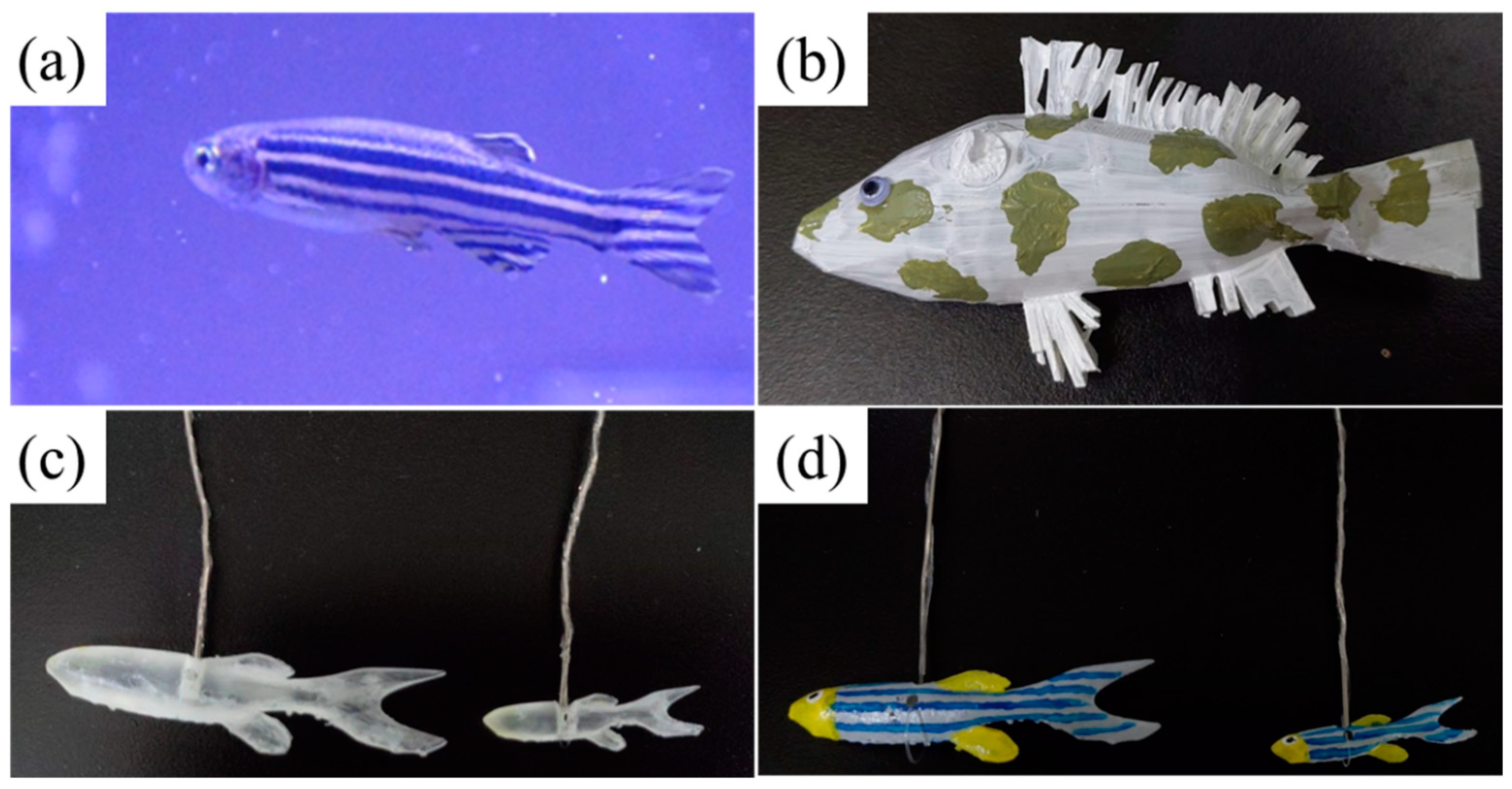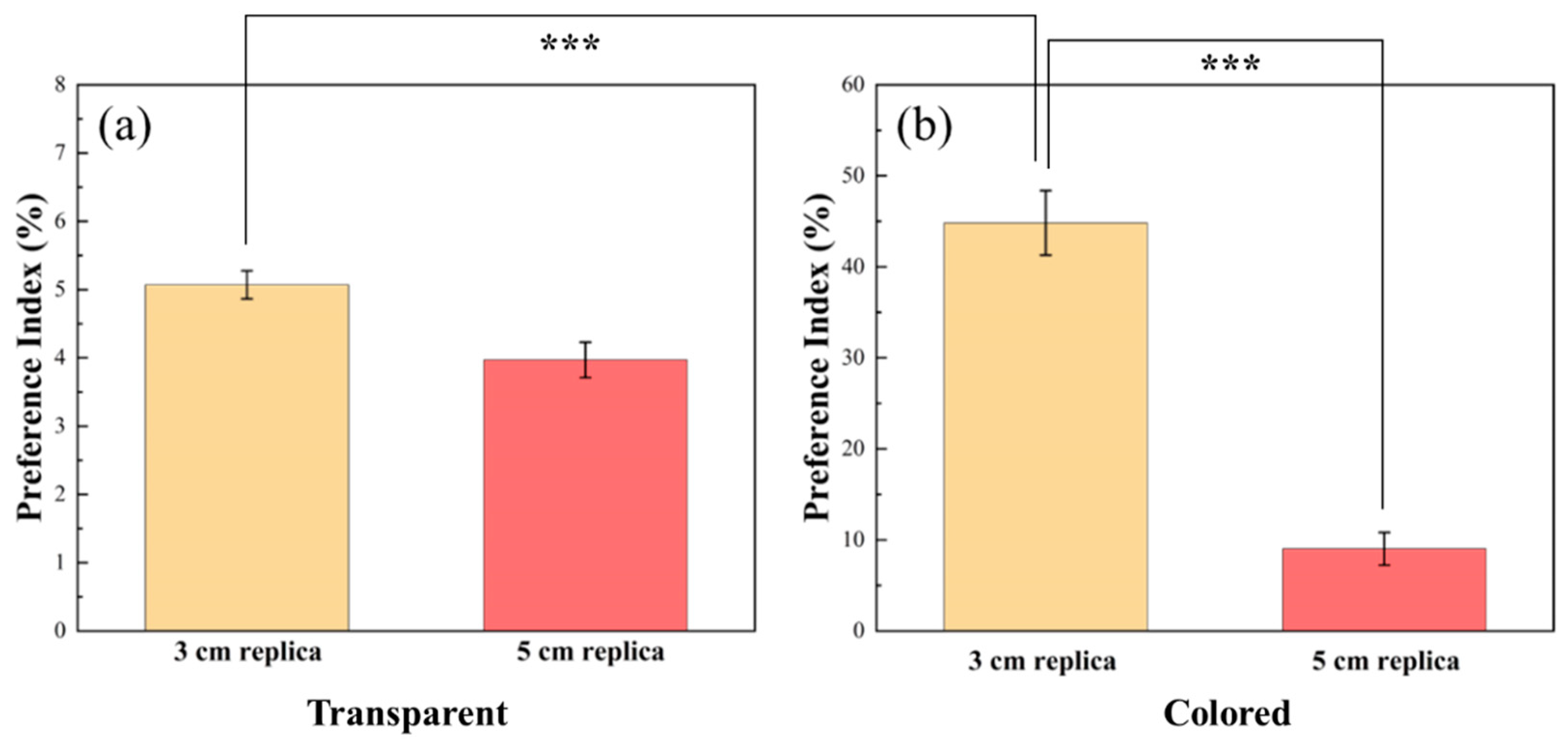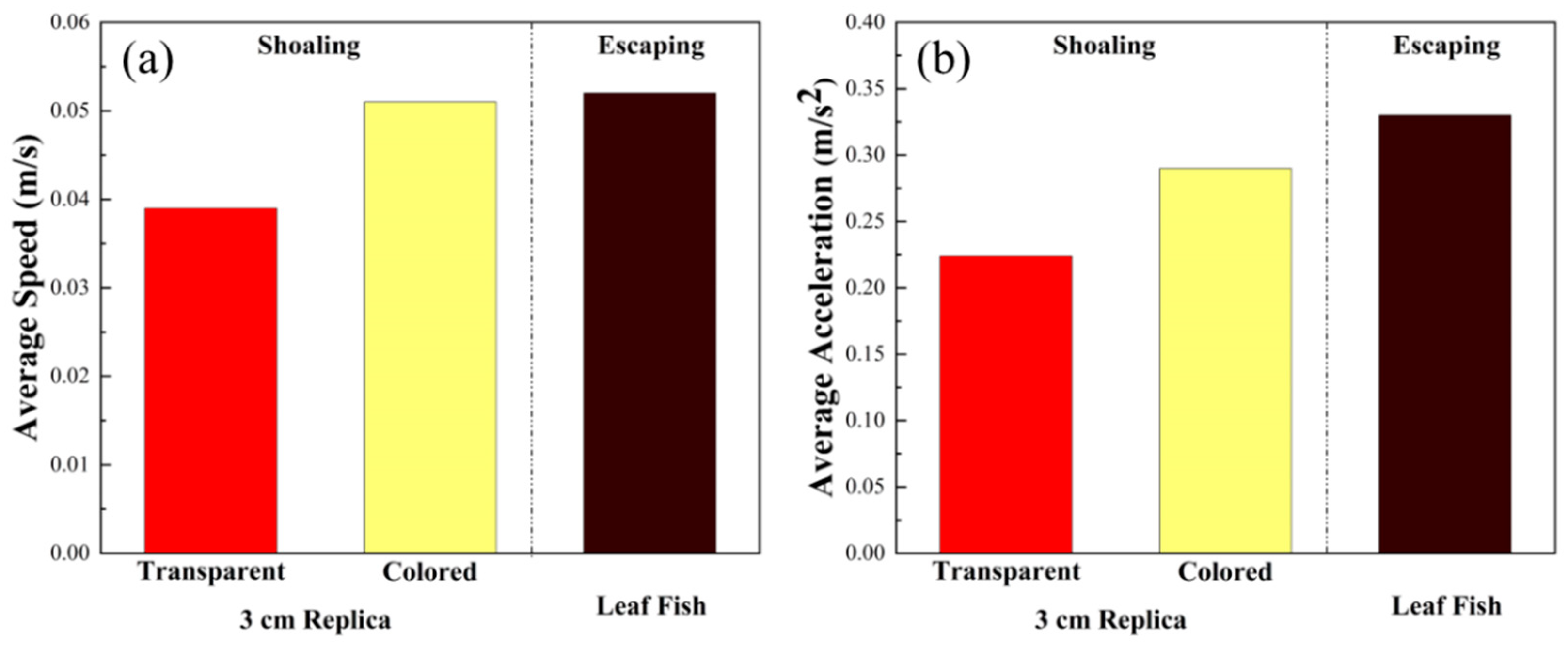Weathering-Resistant Replicas Fabricated by a Three-Dimensional Printing Robotic Platform Induce Shoaling Behavior in Zebrafish
Abstract
:1. Introduction
2. Experimental Section
2.1. Subjects
2.2. Robotic Platform
2.3. Weathering Test
2.4. Shoaling Test
3. Results and Discussion
3.1. Weathering Resistance Experiment
3.1.1. Effect of Sunshine Exposure on the Surface Tension of 3D-Printed Materials
3.1.2. Effect of the Soaking Environment on the Surface Tension of 3D-Printed Materials
3.1.3. Effect of Soaking Environment on the Fracture Strength of 3D-Printed Materials
3.1.4. Effect of Soaking Environment on the Optical Properties of 3D-Printed Materials
3.2. Shoaling Experiment with a Robotic Replica Obtained from 3D-Printed Materials
3.2.1. Transparent Replica Behavior
3.2.2. Colored Replica Characterization
4. Conclusions
Author Contributions
Funding
Acknowledgments
Conflicts of Interest
References
- Panula, P.; Chen, Y.C.; Priyadarshini, M.; Kudo, H.; Semenova, S.; Sundvik, M.; Sallinen, V. The comparative neuroanatomy and neurochemistry of zebrafish CNS systems of relevance to human neuropsychiatric diseases. Neurobiol. Dis. 2010, 40, 46–57. [Google Scholar] [CrossRef] [PubMed]
- Stainier, D.Y.R. Zebrafish genetics and vertebrate heart formation. Nat. Rev. Genet. 2001, 2, 39–48. [Google Scholar] [CrossRef] [PubMed]
- Pan, H.; Zhang, X.; Ren, B.; Yang, H.; Ren, Z.; Wang, W. Toxic assessment of cadmium based on online swimming behavior and the continuous AChE activity in the gill of zebrafish (Danio rerio). Water Air Soil Pollut. 2017, 228, 355. [Google Scholar] [CrossRef]
- Clark, K.J.; Boczek, N.J.; Ekker, S.C. Stressing zebrafish for behavioral genetics. Rev. Neurosci. 2011, 22. [Google Scholar] [CrossRef] [PubMed] [Green Version]
- Phamduy, P.; Polverino, G.; Fuller, R.C.; Porfiri, M. Fish and robot dancing together: Bluefin killifish females respond differently to the courtship of a robot with varying color morphs. Bioinspiration Biomim. 2014, 9, 036021. [Google Scholar]
- DeFrates, K.G.; Franco, D.; Heber-Katz, E.; Messersmith, P.B. Unlocking mammalian regeneration through hypoxia inducible factor one alpha signaling. Biomaterials 2021, 269, 22. [Google Scholar] [CrossRef]
- Mojzesz, M.; Widziolek, M.; Adamek, M.; Orzechowska, U.; Podlasz, P.; Prajsnar, T.K.; Pooranachandran, N.; Pecio, A.; Michalik, A.; Surachetpong, W.; et al. Tilapia lake virus-induced neuroinflammation in Zebrafish: Microglia Activation and Sickness Behavior. Front. Immunol. 2021, 12, 14. [Google Scholar] [CrossRef]
- Leuthold, D.; Kluver, N.; Altenburger, R.; Busch, W. Can environmentally relevant neuroactive chemicals specifically be detected with the locomotor response test in Zebrafish embryos? Environ. Sci. Technol. 2019, 53, 482–493. [Google Scholar] [CrossRef]
- Pitcher, T.J. Functions of Shoaling Behaviour in Teleosts; Springer: New York, NY, USA, 1986; pp. 294–337. [Google Scholar]
- Okada, R.; Ikeno, H.; Aonuma, H.; Ito, E. Biological insights into robotics: Honeybee foraging behavior by a waggle dance. Adv. Robot. 2008, 22, 1665–1681. [Google Scholar] [CrossRef]
- Partan, S.R.; Otovic, P.; Price, V.L.; Brown, S.E. Assessing display variability in wild brown anoles Anolis sagrei using a mechanical lizard model. Curr. Zool. 2011, 57, 140–152. [Google Scholar] [CrossRef] [Green Version]
- Shi, Q.; Ishii, H.; Sugahara, Y.; Takanishi, A.; Huang, Q.; Fukuda, T. Design and control of a biomimetic robotic rat for interaction with laboratory rats. IEEE/ASME Trans. Mechatron. 2015, 20, 1832–1842. [Google Scholar] [CrossRef]
- Lieschke, G.J.; Currie, P.D. Animal models of human disease: Zebrafish swim into view. Nat. Rev. Genet. 2007, 8, 353–367. [Google Scholar] [CrossRef] [PubMed]
- Postlethwait, J.H. Zebrafish comparative genomics and the origins of vertebrate chromosomes. Genome Res. 2000, 10, 1890–1902. [Google Scholar] [CrossRef] [PubMed] [Green Version]
- Romano, D.; Benelli, G.; Donati, E.; Remorini, D.; Canale, A.; Stefanini, C. Multiple cues produced by a robotic fish modulate aggressive behaviour in Siamese fighting fishes. Sci. Rep. 2017, 7, 11. [Google Scholar] [CrossRef] [PubMed] [Green Version]
- Ladu, F.; Mwaffo, V.; Li, J.; Macrì, S.; Porfiri, M. Acute caffeine administration affects zebrafish response to a robotic stimulus. Behav. Brain Res. 2015, 289, 48–54. [Google Scholar] [CrossRef] [Green Version]
- Ruberto, T.; Mwaffo, V.; Singh, S.; Neri, D.; Porfiri, M. Zebrafish response to a robotic replica in three dimensions. R. Soc. Open Sci. 2016, 3, 160505. [Google Scholar] [CrossRef] [Green Version]
- Li, Y.W.; Zheng, L.H.; Peng, S.Q.; Miao, J.T.; Zhong, J.; Wu, L.X.; Weng, Z.X. Structure-property relationship of stereolithography resins containing polysiloxane core-shell nanoparticles. ACS Appl. Mater. Interfaces 2020, 12, 4917–4926. [Google Scholar] [CrossRef]
- Mubarak, S.; Dhamodharan, D.; Divakaran, N.; Kale, M.B.; Senthil, T.; Wu, L.; Wang, J. Enhanced mechanical and thermal properties of stereolithography 3D printed structures by the effects of incorporated controllably annealed anatase TiO2 nanoparticles. Nanomaterials 2020, 10, 79. [Google Scholar] [CrossRef] [Green Version]
- Mohan, D.; Sajab, M.S.; Kaco, H.; Bakarudin, S.B.; Mohamed Noor, A. 3D printing of UV-curable polyurethane incorporated with surface-grafted nanocellulose. Nanomaterials 2019, 9, 1726. [Google Scholar] [CrossRef] [Green Version]
- Park, S.M.; Park, J.M.; Kim, S.K.; Heo, S.J.; Koak, J.Y. Flexural strength of 3D-printing resin materials for provisional fixed dental prostheses. Materials 2020, 13, 3970. [Google Scholar] [CrossRef]
- Miller, N.Y.; Gerlai, R. Shoaling in zebrafish: What we don’t know. Rev. Neurosci. 2011, 22, 17–25. [Google Scholar] [CrossRef] [PubMed]
- Spinello, C.; Macrì, S.; Porfiri, M. Acute ethanol administration affects zebrafish preference for a biologically inspired robot. Alcohol 2013, 47, 391–398. [Google Scholar] [CrossRef] [PubMed]
- Ruberto, T.; Polverino, G.; Porfiri, M. How different is a 3D-printed replica from a conspecific in the eyes of a zebrafish? J. Exp. Anal. Behav. 2017, 107, 279–293. [Google Scholar] [CrossRef] [PubMed]
- Miller, N.; Gerlai, R. From schooling to shoaling: Patterns of collective motion in zebrafish (Danio rerio). PLoS ONE 2012, 7, 6. [Google Scholar] [CrossRef] [PubMed]
- del Pozo, A.; Sanchez-Ferez, J.A.; Sanchez-Vazquez, F.J. Circadian rhythms of self-feeding and locomotor activity in zebrafish (Danio rerio). Chronobiol. Int. 2011, 28, 39–47. [Google Scholar] [CrossRef] [PubMed]
- Polverino, G.; Phamduy, P.; Porfiri, M. Fish and robots swimming together in a water tunnel: Robot color and tail-beat frequency influence fish behavior. PLoS ONE 2013, 8, e77589. [Google Scholar] [CrossRef] [PubMed] [Green Version]
- Pei, X.Q.; Wang, Q.H. Ultraviolet irradiation induced changes in the surface of phenolphthalein poly(ether sulfone) film. Appl. Surf. Sci. 2007, 253, 4550–4553. [Google Scholar] [CrossRef]
- Yang, X.; Ding, X. Prediction of outdoor weathering performance of polypropylene filaments by accelerated weathering tests. Geotext. Geomembr. 2006, 24, 103–109. [Google Scholar] [CrossRef]
- Osawa, Z.; Sunakami, T.; Fukuda, Y. Photodegradation of blends of poly(vinyl chloride) and polyurethane. Polym. Degrad. Stabil. 1994, 43, 61–66. [Google Scholar] [CrossRef]
- Jeong, S.Y.; Tso, C.Y.; Wong, Y.M.; Chao, C.Y.H.; Huang, B. Daytime passive radiative cooling by ultra emissive bio-inspired polymeric surface. Sol. Energy Mater. Sol. Cells 2020, 206, 110296. [Google Scholar] [CrossRef]
- De Lellis, P.; Cadolini, E.; Croce, A.; Yang, Y.P.; di Bernardo, M.; Porfiri, M. Model-based feedback control of live zebrafish behavior via interaction with a robotic replica. IEEE Trans. Robot. 2020, 36, 28–41. [Google Scholar] [CrossRef] [PubMed]
- Bartolini, T.; Mwaffo, V.; Showler, A.; Macrì, S.; Butail, S.; Porfiri, M. Zebrafish response to 3D printed shoals of conspecifics: The effect of body size. Bioinspiration Biomim. 2016, 11, 026003. [Google Scholar] [CrossRef] [PubMed] [Green Version]
- Kalueff, A.V.; Gebhardt, M.; Stewart, A.M.; Cachat, J.M.; Brimmer, M.; Chawla, J.S.; Craddock, C.; Kyzar, E.J.; Roth, A.; Landsman, S.; et al. Towards a comprehensive catalog of zebrafish behavior 1.0 and beyond. Zebrafish 2013, 10, 70–86. [Google Scholar] [CrossRef] [PubMed]










Publisher’s Note: MDPI stays neutral with regard to jurisdictional claims in published maps and institutional affiliations. |
© 2022 by the authors. Licensee MDPI, Basel, Switzerland. This article is an open access article distributed under the terms and conditions of the Creative Commons Attribution (CC BY) license (https://creativecommons.org/licenses/by/4.0/).
Share and Cite
Wu, W.-L.; Li, D.-C.; Chen, Y.-S.; Ko, F.-H. Weathering-Resistant Replicas Fabricated by a Three-Dimensional Printing Robotic Platform Induce Shoaling Behavior in Zebrafish. Sensors 2022, 22, 3481. https://doi.org/10.3390/s22093481
Wu W-L, Li D-C, Chen Y-S, Ko F-H. Weathering-Resistant Replicas Fabricated by a Three-Dimensional Printing Robotic Platform Induce Shoaling Behavior in Zebrafish. Sensors. 2022; 22(9):3481. https://doi.org/10.3390/s22093481
Chicago/Turabian StyleWu, Wei-Lin, Di-Ching Li, Yen-Shuo Chen, and Fu-Hsiang Ko. 2022. "Weathering-Resistant Replicas Fabricated by a Three-Dimensional Printing Robotic Platform Induce Shoaling Behavior in Zebrafish" Sensors 22, no. 9: 3481. https://doi.org/10.3390/s22093481




